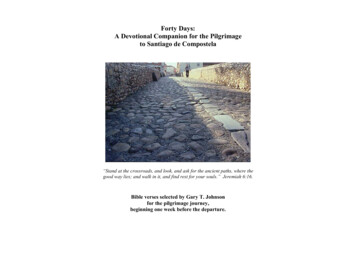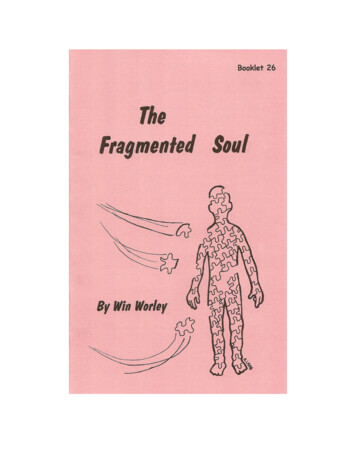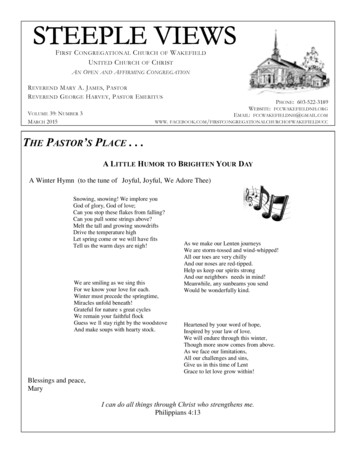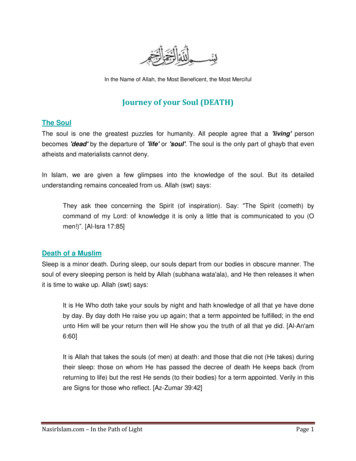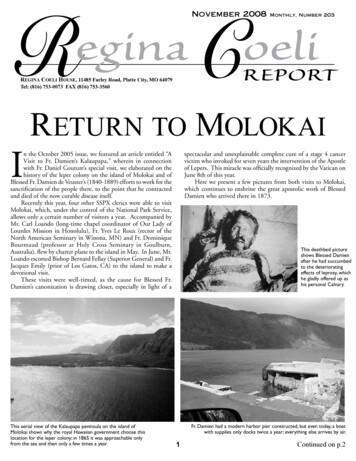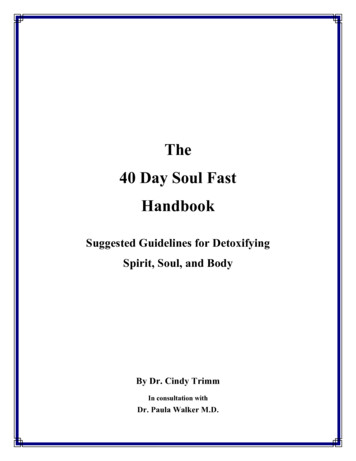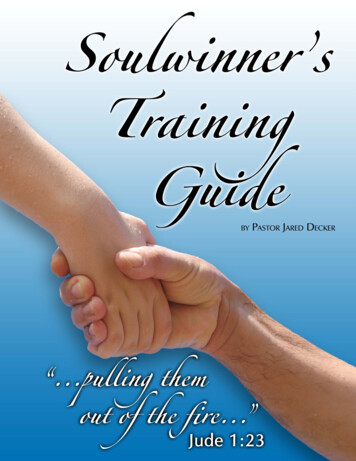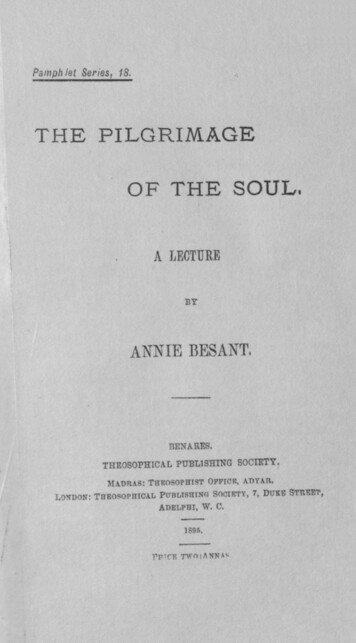
Transcription
Pamphlet Series, 18.THE PILGRIMAGEOF THE SOUL,A LECTUREBYANNIE BESANT.BENARES.THEOSOPHICAL PUBLISHING SOCIETY.MADRAS: THEOSOPHIST OFFICE, ADYAR.LONDON; THEOSOPHICAL PUBLISHING SOCIETY, 7, DUKE STREET,ADELPHI, W. C.1895.PPTCFI TWO I ANN AS
PBINTED BY J. N, 11EBTAAT THECHANDBAPEABHA PBESS COMPANY LIMITED,. BENARES
THE PILGRIMAGE OF THE SOULThis evening my Brothers, I am to speak to yonon " THE PILGRIMAGE OE THE SOUL " and in orderthat the subject may be put clearly before you fromthe beginning, let me, at the very outset, say whatis meant by the title, what is intended by the word' Soul', and exactly say what that word implies. Onedifficulty that we have in dealing with many of thesecomplicated subjects in the English tongue, is, that thattongue is not adapted to the careful definition of subtledistinctions; you do not find in English much habitof metaphysical disquisition, you do not find in Englishany fondness for the drawing of distinctions whichare complicated and subtle in their nature, betweenthe different parts of man's Constitution, and as mindhas been studied from without and not from within,there is difficulty in dealing with man's complicatednature, and oftentimes a single word has to servefor several things, different because of their constitu tion. If I were sure in addressing an Indian audi ence, that every one present knew as he ought toknow, the terms of the Indian Religion, which markout the different stages of man's nature, I might usethe Sanskrit terminology; but I am obliged to remem ber, that though at the present time there are manywho by tradition and by name are Hindus in faith, yetfew of them are acquainted with the details of theterminology which ought to be familiar to them fromchildhood. I must therefore, in addressing men, whohave had their thoughts turned to occidental eduea-
(2)tion rather than to the study of the ancient IndianLiterature, in using Sanskrit terms be sure that theterm is understood, and must give the equivalent inEnglish, however unsatisfactory and loose that equi valent may be.Now then, what is the meaning of this exceedinglyvague word, used so vaguely by the English them selves that you will find a large number of themspeak of Soul and Spirit as though the two terms werenot distinct, but conveyed the same idea; so that theyspeak of a man's Soul and a man's Spirit almost inter changeably. If you ask what distinction they drawbetween Soul and Spirit, you will often be met byan expression of- surprise, and the statement that thetwo words really mean the same thing, and that it isnot necessary to go into these fine-drawn distinctions.But as a matter of fact, though they may be cons tantly thus used in the same sense, they ought not tobe taken as implying the same. Therefore it is thatI think it necessary to show what the meanings of thetwo terms are, in order that we may be able to followthe pilgrimage of the Soul.The word "pilgrimage" would be altogether in apposite if I were speaking of the Spirit, Spirit beingchangeless, immutable, eternal, incapable of increaseor diminution, and therefore a thing which can notbe spoken of, as performing a pilgrimage, of whichthe very object is the gathering of experience and thegaining of capacities which were not in existencewhen the pilgrimage was begun. Therefore let metell you that by the word "Spirit" I shall mean thatwhich in Sanskrit would be connoted by the wordAt,ma—that is, the universal spirit which is at theroot of manifestation, which is one and the same for
(8)every man, which is present not only in man but inevery atom of the universe, without which there isnothing that has existence, without which nothingcan be, which is that from which everything pro ceeds; that which is unborn and undying. Butsometimes you know that a distinction in term isdrawn for the sake of convenience between Paramatma and Atma; but the distinction is not one of es sence-, it is one of condition: Paramatma signifyingthe spirit underlying the whole of the universe;while Atma is that same spirit in the heart of andembodied in, man. Thus in the Clihnndogyopanishad,there is this distinction drawn between the embodiedand the unembodied Atma.You use the word Atma when you want to makeit clear that the Spirit itself is at the root of man'sexistence, and is, as it were, at the centre of mani festation; then you must realise clearly and definitely,that the Spirit is changeless, that in itself it is oneand not many, that in itself it is immutable and nottransitory. But you must also realise and considervery clearly its activity, for in the Upanishads it isoften stated that Atma is the outgoing energy ofeverything which is born, so that while in itself it isquiescent, it has under certain conditions made allthat is manifest, and under these conditions it be comes the one life issuing from different conditionsaccording to each form of manifestation, and becom ing as it were individualised by means of the condi tions, although in itself individuality cannot be pre dicated of it.Understand then that in using two distinctiveterms, Spirit and Soul, we mean to imply difference,and having defined Spirit, what is meant by the word
(4)Soul ? Turn for a moment in thought to that greatteaching of Shri Krishna, in which he instructs hisdisciple Arjuna that Spirit is unborn, undying, change less, inexhaustible, eternal; and yet in the same breathhe speaks to him by name as having many timesbefore been born, addressing him as an individual,addressing him as a separated entity, separated fromother entities, distinguishing between His disciple andHimself, and saying that the former had been bornmany times before, but did not remember it, whileHe Shri Krishna knew his previous births. So thatyou find in that instruction the distinction drawnbetween the One, immutable, unborn, undying Spirit,which is one and the same for all, and separated en tities who had passed through many births before,whose knowledge differed, the one from the other,whose experience in the past differed, the one fromthe other; so that you find individuality, you find se paration, you find there an entity which can bedistinguished from another entity. In every onethere is some difference which has come in betweenthe Spirit which is not individualised, and those, atleast for a time, separated individualities, for theypass through different births and have garnered inthem the fruits of past experienceNor is that all. In another division of the samegreat book you will find a similar truth given byway of analogy, that as one sun lights all, so oneSpirit illumines every form. We find one glorioussun lightening different bodies in the world, one sunbut its rays falling upon many bodies around us. Thesun's rays are the same in themselves, but as theyfall upon different kinds of bodies in which matteris differently arranged, these rays falling upon these
(5)different arrangements of matter are thrown backfrom them to the eyes of men and beautiful are thecolours which result. Now colour is nothing morethan a result of light falling upon the differentarrangements of matter which retain some rays inthe spectrum and reflect others. In looking at atree you see the leaves are green, that is simply be cause light falling upon a particular arrangement ofmatter which you call a leaf has part of its raysabsorded by the leaf and the other part thrown in wards to the eye and the leaf has a green colourbecause the green ray is reflected to your eye. Sowith a red body, with a blue or a yellow. Thus thesimile is very exact. Just as the one white light ofthe sun comes back in so many different colours notbecause the sun is different or the rays different,but because the arrangements of matter on whichthey fall are differently associated, and therefore theray thrown back is only part of the white light; soin the Souls, the different Souls of men, which areindividualised, the separate charactristics, the differ ent qualifications which you see in them are builtby experience, are built by the long pilgrimage ofthe Soul, passing through birth after birth, in eachbirth gathering different experiences, and these makedifferent arrangements of Soul material, as it were,and the one Spirit shines through these individualisedSouls and you see each as different; we know theindividual by the difference of his attributes, theattributes being the colours of the soul.Now when that thought is grasped, let me see theSoul's future this evening—using the word Soul asSpirit individualised that is, as an entity which beginsas the "I" in us which shows certain qualities, which
(6)exhibits certain powers; which shows strength andweakness, which grows and develops from life to life.What I have to do this evening is to trace the pilgri mage and show you the process of individualisation;to show you how the process begins, how it continuesand the object for which this pilgrimage is made;what there is that comes out at the end different fromwhat there was at the beginning; what is the goalwhich this individualised Spirit has ultimately toreach, for which it passes from life to life and is re born over and over again; what is the object of thegathering of experience, what the meaning of thatwheel of birth and death to which every one of us isbound and upon which every one of us is revolving,but from which liberation may be gained—aye, shallultimately be gained, for if we are bound to that bythe bonds of desire, then as the bonds of desire arebroken, the Soul is set free and is no longer subjectto birth and death.Now as to Desire, as to the nature of it, much dis cussion has arisen, much controversy as to why theprocess should be, much controversy as to the begin ning and the ending in times of manifestation. Letus see if we can understand the purpose of humanlife and throw some light on its obscurities. Comeback with me to the times of old when man as we knowman did not exist. In asking you to come back withme to the times when man, as we know man did notexist on the earth, when so to speak the house wasbuilding, in which there was to be a tenant that wecall the Soul, let me remind you that in building ahouse, the walls of the house have to be built, theroof must be placed upon them before you can enterand use it as a habitation; and so with the habitation
(7)built gradually for the Soul, we may see that housebeing built; we know that the bodies which wewear are not ourselves, a man's body is not himselfnor is your body you. ' It is not you, the identity isnot with the body, but the body is as a garmentwhich you take up and lay aside at will, the garmentwhich wears out like everything else upon this chan ging earth; but the Living Self, the conscious Ego isthe individuality which needs the body, and uses itand takes one body after another for its purposes.Remember always that where there is manifesta tion there is a double aspect of the One, form and life,remember that whenever there is a universe, or anybody in a universe, both these aspects must be pre sent; remember that they are inseparable, and thateverywhere in the great and small there is the doubleaspect of the One, underlying life and mind. Wemay distinguish the one as Purusha and the other asPTahiti, both threefold in their natures. You cantrace them in the building of man; you may tracethem in the earlier stage of making his garment, andyou will find in the Aitareyopanisliad a very distin guishing mark where it is said that Paramatma drewthe form of man out of the water. This is the firststage; what does it mean ? Water is always the sym bol under which the form-side of nature is expressed.Water is that which stands for matter in the sacredbooks of the world. When we find the word "water"used it means Prakriti, it means physical nature.The other aspect is symbolised by fire. You will seesometimes in a temple a double triangle as a symbol,the upward pointing triangle is the threefold Puru sha; the threefold Prakriti being symbolised by thedownward pointing triangle; the flame of fire pointing
( 8 )upwards, the water dropping downwards. Fire andwater, everywhere represent spirit and matter. Thusthis drawing of the form of man out of the watermeans the building of his astral and physical bodiesout of matter, and it is drawn out by Paramatmabecause the building is brooded over and caused byAtma. What is the next stage according to the sameUpanishud ? It is the entering in of the Devas, whoentered in these forms which were drawn from thewater; these Devas entering the body become thesenses of man. That is to say, that the / evas, whoare the spiritual intelligences behind phenomena,build the inner body in which reside the active sen ses of man. Not the bodily organ, but the seeingsight; not the bodily organ, but the sense of hearing;not the bodily organ, but the power of speech; notthe bodily organ, but the sense of touch. All thesesense-centres result from the Devas who are con cerned with the different types and kinds of percep tion, and who entering the form which was drawnout of the water, give to men the power of sensation,the power of feeling, of response to outer contacts.So it is written, tbat one entered in and becamespeech, another entered in and became sight, andanother became hearing and so on. Thus the secondstage of the building of this tabernacle for the Soulis the entering in of the Devas, which added to theouter bodies the inner body that feels, which addedthese powers of sensation, without which the instru ment would not be adapted for the gathering ofexperience. Thus the second stage in the formationof man's tabernacle is that which in Theosophicalliterature is described as the building of the Kamienature of man, the nature of desire, the nature which
(9)feels, the nature which sensates, the nature whichperceives pleasure and pain and thus exactly, alongthe same lines, you may find other great writersfollowing these teachings of the Upanishads.Take the institutes of the great teacher Manuand there you find the same distinctions made byhim; first there is the "Self of the elements" that hecalls the "body of action", the outer body which ismade up of the elements, and next another body whichhe calls "the body of Jiva" and this is explained tomean the body of feelings. He says it is the body inwhich is experienced pleasure and pain; and thatthe body is formed for the very purpose of theseexperiences of pleasure and pain. So I may pointout that in the Chliandogyopanisliad the same lines ofteaching are laid down, and it is said, that Atmatakes on a body in order that it may come into con tact with pleasures and pains, for only the embodiedAtma comes into contact with anything external tothe body. And thus only can it come into contactwith objects from which it experiences pleasure andpain. And then he goes on to say that where thereis this embodied Atma there is the power of sensation,of pleasures and of pains. Therefore if you workthis out, you will find that all come to the same teaching though in different forms, and that the humanbeing consists primarily of the Universal Spirit,Atma, and that there is built up by this a double body,the body of action and the body of feeling, and thatthis is to be the. dwelling place for something whichis called the Soul, in order that it may perceivepain and pleasure, and by means of this gain experi ences which otherwise he could not have gained. Andit is elsewhere said that Atma is like the breeze which2
(10 )plays over a garden of flowers. It does not gatherthe flowers, it does not pick the blossoms, but whenthe breeze has entered the garden and played overthe fragrant blossoms, it picks up from each blossomits peculiar fragrance and carries that fragranceonwards, so that when it leaves the garden, it is en riched with the varied fragrance of the differentflowers. No longer as it came in, without scent,without sweetness, but gathering up the scent of theflowers it goes on, retaining the fragrance it hasgarnered. And so with At ma in the world of mani festations. It does not gather phenomena themselves,it does not take as it were the experiences themselves,but by a subtle process it uses the bodies, the bodiesof action and of feeling, for the gathering of experi ence, and then the Soul gathers up the fragrance,the aroma as it were, the ideal reflection of the ex periences and carries them forward with it till thepilgrimage of the Soul is over."Where is the use of the Soul ? It is to be thegarner house, the receptacle, in which, every experi ence shall be kept as an ideal refleciion not in thegross form of the fact or the sensation, but in anidealised form, which shall remain as. a permanentrepresentation of that which has been experienced ingaining knowledge of the external world.And now I think we are ready for the third step.In the same Upunishad from which I have beforequoted, the Aitareyopanishad, it is stated that theouter form being ready, the Devas % having enteredin, there followed the third stage, when Paramatmasaid:—"How shall I enter in ?" and then it enteredby the sacred place in the head, and then we may«ay there was Man: not before. This is the junction
(11)of two definite lines of evolution, and at the point ofjunction there is the formation of the individual, theEgo. Let me see if I can make that clear. In thebuilding of the bodies of men, in the building of thebodies of action and of feeling, you have seen a greatdeal of the working of the Prakritie side of evolu tion. Let me now use a term which you ought notto misunderstand—I call it the female side of Nature.You will see in a moment why I use that term drawnfrom experiences in the life of the world. Thisdouble evolution of Purusha and Pmkriti is the pri mary fact, from which results on our plane what wecall the male and the female. Their functions aredifferent. The work of the one is the pouring forthof the creative and life-giving energy. It generates,it fertilises, it is active and controlling. The otherside is the receptive side, the side that nourishes, theside that feeds, the side that develops, that as itwere, receives the energy of the generating spirit andnurtures within its own womb the growing lifewhich has been given to it, and makes it possihle forthat life to be developed. This difference of functiongoes through the whole of nature. All evolution isgoverned by this duality which gives rise to a newindividual when it unites, one germinating the lifeincarnate, the other developing the life. That lifeis always thrown out by the generator, and thenreceived by the nourisher and nourished into whatis called the individual.Now analyse this truth of nature : Brahman isone, there is but one life and one law, there is butone'eternal existence of which everything is the ma nifestation. Therefore we can unravel many of thepuzzles by studying the facts on the lower plane and
( 12 )we may sometimes render it easier to grasp the higherfacts, but remember that what you have to do ifyou would understand" rightly is not to study thethings of the spirit with the eyes of the flesh. Youmust not carnalise spirituality, but on the contraryyou must spiritualise carnality, and then you mayhope by the Spirit in yourself to throw light uponmany problems and to find their solutions, whichotherwise without its aid would be entirely unsoluble.I am now going to take an analogy from the lowernature, because I should not otherwise convey mymeaning to those who are trying to understand.Analogy helps us because it gives us a picture; andall real things, all force, all life, all spirit are moreeasily understood by pictures than by any language.For spiritual truths are not taught by language, spi ritual teaching is not by words, but as it were, bypictures recognised by direct intuition. But in asmuch as you and I are working through the intellect,I must use the awkward vehicle of language andtherefore must ask the help of the intelligence toconvey to you the thoughts which I wish to have inyour minds.Suppose you take a plant, and plucking a flower,examine its centre; in the centre you will find a smallbody, within that, smaller bodies; select one of theseand open it, and with the help of a microscope youwill find a body which is still more minute. I seemto be talking science, but I am really following theadmirable ancient example of Uddalaka ; for youmay remember that father teaching his son; you mayremember how he made him take the plant andexamine it bit by bit until he came upon the apparent ly empty centre where the whole future tree was
(13 )though hidden in the invisible. So that I am onlyfollowing the ancient example of teaching throughphysical nature, though utilising modern scientificthought. Pursuing our search microscopically weshall reach the ultimate possible point which youcan trace by the present instruments and we shallfind that there is a single germ—a germ which ifleft to itself will die, the germ if left to itself, willnever develop, the germ if left to itself will justremain a small point and nothing more, will witherand come to an end. But suppose that instead ofbeing left to itself, there is brought to it another kindof matter, stimulating and fertilising, it will live andfrom the male organ of the plant there will come to itthat embodied energy, which falling upon the germ,will unite itself with it and fertilise it. What willbe the result ? The result will be that out of thatgerm which has been fertilised by the male energythere will grow up a new plant, there will developea new individual, which will reproduce the charac teristics of the parents that gave it birth, and it willbe a separate individual, dating its beginning as anindividual from the point of junction; separately,neither of these could give rise to the new individual,but in the union of the two the new individual iagenerated.Now let us apply that analogy, and let us seehow it may help us in this building of the bodieswhich form the human tabernacle. Now we have inthose two bodies as it were, the female side of na ture. Mere bodies which are capable of giving nou rishment to the Soul, which are capable of feedingthe Soul by the gathering of experience, which willserve as the link between the outside world and that
(14) which is to be within; and you have in them thecharacteristics of the female side of nature, thenourishing side which builds up the individual.Another building will be by the gathering ofexperience, without which no growth can occur, andon the assimilation of which the whole of the deve lopment of the Soul depends.The Soul cannot be built within this receptaclethat encompasses that germ, if that germ be left toits own unassisted energies. Something else mustcome in, in order that the germ may become a livingindividual, some other energy must come in to giveit the impulse which shall cause future growth.Whence does it come ? It comes from those Spiri tual Intelligences of whom you have heard, of whomyou have read, spoken of sometimes as the Kumaras,sometimes as the mind-born sons of Bralima, thosewho were at the beginning of the Manvartara, theMighty Ones who came out at the beginning of theuniverse, of manifestation, to take part in this buil ding of the universe and to generate man. Thesacred books speak of such great ones and they arespoken of as men. But where will you find men likeThose ? They are the sons of Prajapnti comman ded to populate the globe, those who went down intothe ocean, ancient and mighty sages, embodied souls,and there meditated for ten thousand years, thencoming up from the waters they populated the en tire globe.Let us see the meaning of this story as appliedto the building up of men. The sons of Prajapatibeneath the surface of the waters are Spiritual Intelli gences merged in Atma by supreme meditation; theycome out from beneath the surface of the ocean, out
( 15 )of Pralaya into active manifestation. They are thedeveloped intelligences of a past Manvantarci thathave in a previous universe developed self-consci ousness. They have developed thought. They havedeveloped Spiritual intelligence, and it is they whocome along the line of intellectual evolution, andwho cume down when the receptacles are ready,which have been builded for this purpose. Into thebody made by the Devas, the body of Feeling or theKama Rupn, they throw a spark, a spark of Theirown essence; it is a spark of mind; it is a spark ofintelligence and it falls into the prepared receptaclewith its stimulating energy and coming into contactwith the germ develops in the female. Purushaacts upon the Prakriti with fertilising power andgenerates a new individual, a new Ego, which is todevelop into a new intelligent being, a Soul, that is,Spirit individualised by separate experiences. Thereat the point of junction it is, that the individual isborn, there it is that the individual, the Soul, beginsas an individual and which is thence forward togrow and to develop; there is the begining of thepilgrimage which is to end in Nirvana.Take now this thought at your leisure and inthinking it out refer, sthese various passagesto show to you whence the arguments are drawn;then think the matter out, slowly but with the helpof the key which has been given to us in H. P.Blavatsky's Secret Doctrine, that priceless messageto man, throwing light on obscure problems of ourbeing, and you will begin to understand the meaningof the hints given and you will understand then themeaning of the phrase, that when the mind-born
(16)sons came down, with their own essence they filledthe Kama, some entered in, while others projecteda spark. For those who entered into the preparedbodies were the great Risliis who in the beginningof each Race come upon Earth and take a body inorder that they may guide the infant Humanity,may train it, give to it the revelation which is neededby it, the guidance and the impulse which arenecessary for its growth. Whence do you supposethese Risliis come, who do you suppose are thesemighty mind-born children of the highest, that theyshould take upon themselves human bodies and be come the teachers of infant Humanity ? Who gene rated that Humanity, who stood round its cradle,and watched its growth in order to guide it along theright way to Life ? Those " entering in" they werethe Risliis, while some projected a spark, a sparkthat was an infant Soul. Thus were the new men thesons of the Ancient ones, the Father-Souls; their chil dren were infant Souls, knowing nothing, withoutexperience, but thrown into bodies which could betrained, thrown into bodies in which they might comeinto contact with the outer world and translate the con tact into pleasure and pain. What will be the resultof the first experience ? This child-soul is absolutelyignorant; ignorant of the capacities of its own body,ignorant of the existence of an outer world. Thatworld is a world of Law. There are things outsidewhich attract this baby-soul, things which are attrac tive to the sense of sight, to the sense of hearing, toall the senses of this body of feeling which is to beits instrument for coming into contact with objectsand experiencing pleasure and pain. Following theattractions of things outside it, it goes after them
(1')and coming into contact with them by means of thesense organs, it experiences pleasurable or painfulsensations according to the relations between the outerbody and the inner energy. Thus in the infant Soulthere will arise, where there is contact, the feelingof pleasure or of pain. Do not make a mistake inyour thought. Pleasure and pain are not in theSoul, pleasure and pain lie at the point of contactbetween the energy which the Soul is liberating andthe energy from the external body, which is also vib rating; neither vibration separately causing pleasureor pain. But when the two meet, at the point ofcontact there is either harmony or discordance. Ifthey are harmonious, that is translated as pleasureby the Soul; but if there is discordance, that is trans lated as pain. Pleasure and pain then are the resultsof the contact between the two sets of vibrations andare neither in the external body alone, nor in theSoul alone, that experiences the contact. Supposingthis outgoing energy vibrating from the organs ofthe senses, comes into contact with a vibration har monious with it, what is called a pleasurable feelingresults. This will affect the Soul as a feeling ofpleasure, and the Soul will desire a repetition of itand will seek that experience again. It will be aconsiderable time before that baby-soul relates to theexternal body the feeling of harmony which is calledpleasure, for a long time this sensation will notresult in a definite thought, for thought begins as aconnexion between object and sensation, by a per ception, that is, a recognition of the object as givingrise to the sensation. The first thought of that babysoul is the recognition of a certain object as causinga certain sensation, joining together feeling with thenO
(18)external body which causes the feeling. For a longtime there will be sensation without perception,consciousness without recognition. Why ? Becauseconsciousness lies in the mere response to an exter nal stimulus; but self-consciousness, the Ego, recog nises relations between the external and the internal,the "not-I" and the "I" and is developed by the fur ther process of working upon internal images, resul ting from sensations and recognising the relationsbetween these images; then passing on to what wecall abstract thought, based on comparison and analy sis. But our baby-soul is only gathering and acquir ing experience as material for future growth; andslowly it learns what makes pleasure and what makespain to it. Then comes its first dim perception ofLaw; only by these feelings of pleasure and pain willit learn there is a law; only by pleasure and pain,then it learns to keep away from somethings and toseek others, and so
speak of Soul and Spirit as though the two terms were not distinct, but conveyed the same idea; so that they speak of a man's Soul and a man's Spirit almost inter changeably. If you ask what distinction they draw between Soul and Spirit, you will often be met


